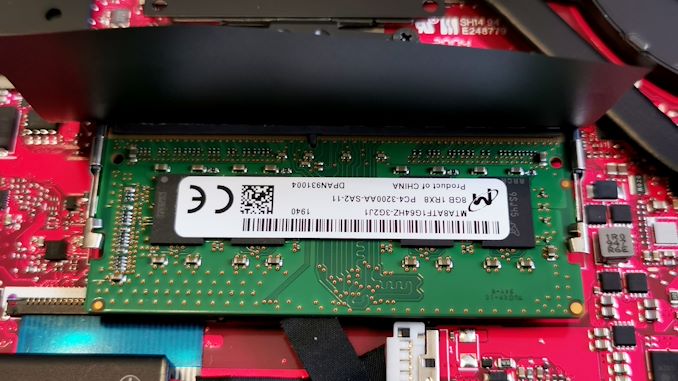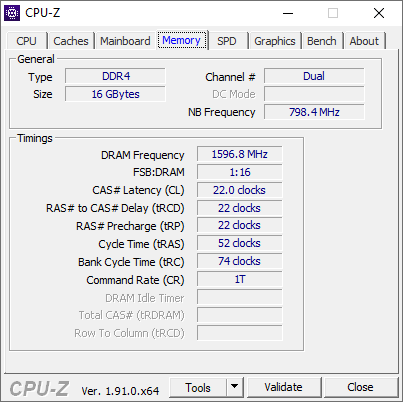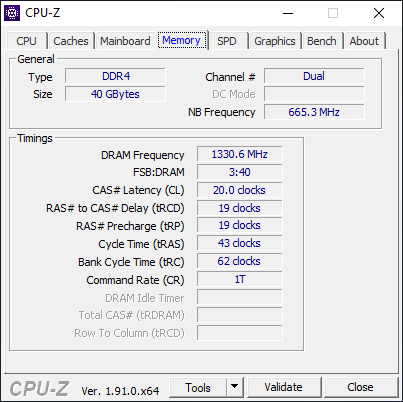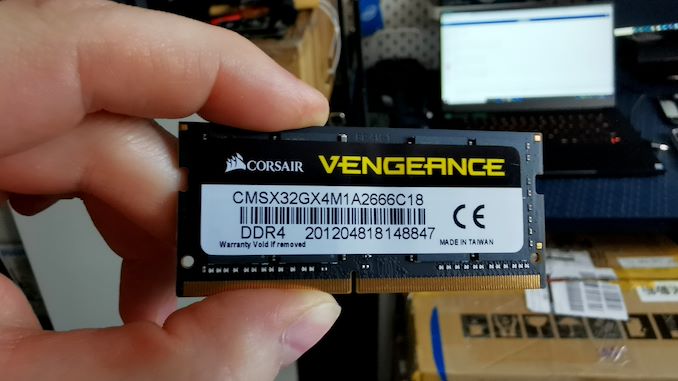AMD’s Mobile Revival: Redefining the Notebook Business with the Ryzen 9 4900HS (A Review)
by Dr. Ian Cutress on April 9, 2020 9:00 AM ESTRyzen 9 4900HS with DDR4-2666 and DDR4-3000
In our ASUS Zephyrus G14, we have a total of 16 GB of DDR4. This is split between a single SO-DIMM module of 8 GB, and a set of 8 GB memory soldered onto the board. AMD will offer a version with 16 / 16, however this might come at a later date.
This memory is running at the AMD recommended for these processors, DDR4-3200. Through our inspection tools, we can tell that this memory is running with subtimings of 22-22-22 with a command rate of 1T. The command rate is certainly good, however the 22-22-22 is a little slower than what we see on a desktop system running at this speed, because here we have a system that conforms to JEDEC’s subtiming requirements.
For our memory testing we wanted to see what speeds and capacities we could achieve. Corsair very kindly sent us some modules of 16 GB DDR4-3000 and a module of 32 GB DDR4-2666. This would give our system either 24 GB or 40 GB total respectively, which for a machine designed to do heavier duty workloads, having >16 GB is certainly welcome, as long as the performance hit isn’t too much.
I installed the 32 GB module, and the system booted first time with no fuss. A quick look to see if all the capacity was seen, and we had a total of 40 GB. The speed was also as expected, at DDR4-2666 but with subtimings of 20-19-19 1T.
However, when we put in the module of 16 GB DDR4-3000, to get a total of 24 GB, the detected speed inside the system was only DDR4-2666. Looking at the module settings, this was because the DDR4-3000 speed was actually an XMP profile, and ASUS has not enabled the ability to set XMP profiles here.
We were able to get DDR4-2666 on the 32 GB module because this is the base frequency and settings for the module. The same with the 8 GB module that came with the system – it was flashed so that the basic SPD setting was DDR4-3200. If users want to get high capacity modules with the faster DRAM speeds on this system, they will have to configure the primary SPD profile of their modules, which isn’t an easy thing to do.
As a result, our tests are going to come down to the 8 GB DDR4-3200 module that came with the system, and compare it to the 32 GB DDR4-2666 module. Note that the latter is an 8+32 configuration, which is expected to run in dual channel for the first 16 GB, and then single channel for the next 24 GB.



With our AI test, there’s a ~20% benefit from having the faster memory, which decreases slightly when moved to a limited power budget.

We didn’t see any difference in something like Cinebench.

There was more of a difference in PCMark 10, however PCM10 isn't that great in showing where the bottlenecks are.
Integrated Graphics Tests


For the Civ 6 graphics test, the difference in performance between the two memory settings is really significant. This sort of game cares less about FPS, however going down to 22 FPS for 1080p Max and No MSAA means that the user probably has to dial that back a bit to get something more reasonable.


Going from plugged in to not plugged in, we didn’t see much of a change with the slower memory, however the DDR4-3200 setting still gets a serious benefit over the DDR4-2666 arrangement.

For Final Fantasy, there a significant change - moving up from DDR4-2666 to DDR4-3200 affords a +30% improvement.
Discrete Graphics Tests




In each case, the faster DRAM actually improves discrete graphics performance.
Quick Thoughts
Overall, 16 GB of memory in a system like this isn't the best configuration - people who need the power are going to likely want 32 GB. However, users putting in their own fast module when buying the 16 GB version are going to have to be careful about the performance. Both the integrated graphics and the discrete graphics take a knock on performance going down from DDR4-3200 to DDR4-2666.















267 Comments
View All Comments
Dodozoid - Monday, April 13, 2020 - link
Yes, to the external one. Vega 8 gpu-z screen says pci-e 4.0 16x.realbabilu - Saturday, April 11, 2020 - link
I saw the absent of hdd 2.5 inch tray. Maybe it is why asus can have 14 inch form instead usual 15 inch form i7-9750H. The weight almost same with my cheap Msi 9RCX i7-9750H notebook around 1.6-1.7 kgs. Still 10H battery life and those raw power nailed it.oleyska - Saturday, April 11, 2020 - link
On the IGP page (first) you say L3 cache, it has bigger L2 cache and not L3 :)Also, what IF\Memory frequency does the 3950X run at in the latency test ?
Could it be compared at 1600 vs 1600 ? what if IF and memory is at 1800 ?
really good write-up!
Hrel - Saturday, April 11, 2020 - link
I wonder how much of this battery life gain that's being attributed to AMD is actually thanks to Nvidia. RTX 2060 shouldn't be compared to RTX 2060 MaxQ, that's pretty ridiculous. I'm willing to bet that's most of that extra 5 hours. Still, good on AMD, but why misrepresent it?SolarBear28 - Sunday, April 12, 2020 - link
You think 12 hours of battery life is possible using the discrete GPU? Its using the integrated vega graphics for the video playback and web battery tests.Santoval - Sunday, April 12, 2020 - link
It is extremely disappointing that a laptop of the caliber of Zephyrus G14 has a QLC based SSD. Who cares about the 1 TB of storage when as a trade-off you get piss-poor performance and the piss-poorest of endurance? QLC was originally employed in largely read intensive servers and now it shows up in SSDs for ... gaming laptops. Seriously Asus?Deicidium369 - Monday, April 13, 2020 - link
I have one of Samsung's first QLC drives, it has been used continuously since new, and has zero issues. Also have one the early OCZ 120GB drives - bought the day it dropped - has been used continuously since new - pulled it and reformatted it and tested - still 0 bad cells. So the whole endurance thing is WAY overblown...AntonErtl - Sunday, April 12, 2020 - link
Thank you for the review. A very good showing for the Ryzen 4xxxH series, now awaiting U reviews:-).There is one thing that I find disappointing: If I understand your review correctly, both memory controllers run at the same clock, so putting in a slower DIMM also slows down the soldered-in RAM. With the memory controllers and the infinity fabric clocks locked together, I should have expected that, but has AMD not loosened the lock recently? In any case, what I would love to see from laptops with partially soldered-in memory in the future would be that they soldered in LPDDR4x memory for better bandwidth (not sure if it saves power), and an independently clocked DDR4 DIMM. Maybe we will see it in Ryzen 5xxx APUs.
Curiousland - Sunday, April 12, 2020 - link
A general comment that most people missed the point -- Ryzen 4000 shows the potential of some optimization work on 7nm process as well as on the zen2 design and can improve when comparing the performance to the early version of zen2 on desktop ryzen 3000!This implies the further potential performance improve of zen3 ryzen 4000 can bring to the market even before they jump on TSMC 5nm for zen4.
Curiousland - Sunday, April 12, 2020 - link
I guess this is why Dr. Su said they are focusing on chip design architecture now more than rushing to next 5nm node. They must have seen plenty of potential of improvement along on 7nm for now already.